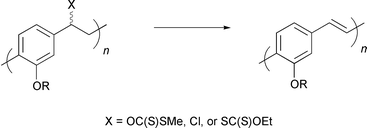Abstract
Poly[2-(2′-ethylhexyloxy)-1,4-phenylenevinylene] (EHPPV) was prepared via

- This article is part of the themed collection: Metal-organic conductors (enriched issue)
* Corresponding authors
a The Dyson Perrins Laboratory, Oxford University, South Parks Road, Oxford, UK
b Department of Physics, Durham University, South Road, Durham, UK
c School of Physics and Astronomy, University of St. Andrews, North Haugh, St. Andrews, Fife, UK
Poly[2-(2′-ethylhexyloxy)-1,4-phenylenevinylene] (EHPPV) was prepared via

 Please wait while we load your content...
Something went wrong. Try again?
Please wait while we load your content...
Something went wrong. Try again?
Control of
S. Lo, L. Pålsson, M. Kilitziraki, P. L. Burn and I. D. W. Samuel, J. Mater. Chem., 2001, 11, 2228 DOI: 10.1039/B106115C
To request permission to reproduce material from this article, please go to the Copyright Clearance Center request page.
If you are an author contributing to an RSC publication, you do not need to request permission provided correct acknowledgement is given.
If you are the author of this article, you do not need to request permission to reproduce figures and diagrams provided correct acknowledgement is given. If you want to reproduce the whole article in a third-party publication (excluding your thesis/dissertation for which permission is not required) please go to the Copyright Clearance Center request page.
Read more about how to correctly acknowledge RSC content.
 Fetching data from CrossRef.
Fetching data from CrossRef.
This may take some time to load.
Loading related content
